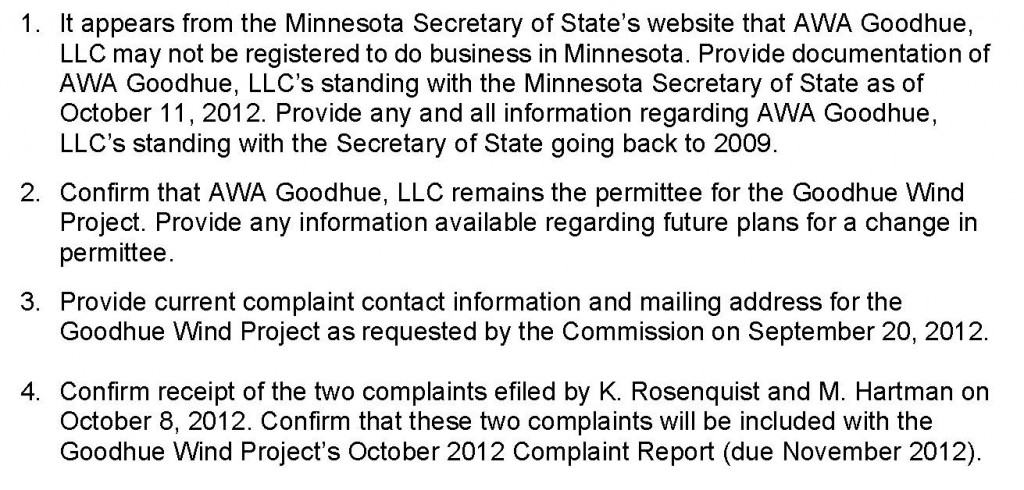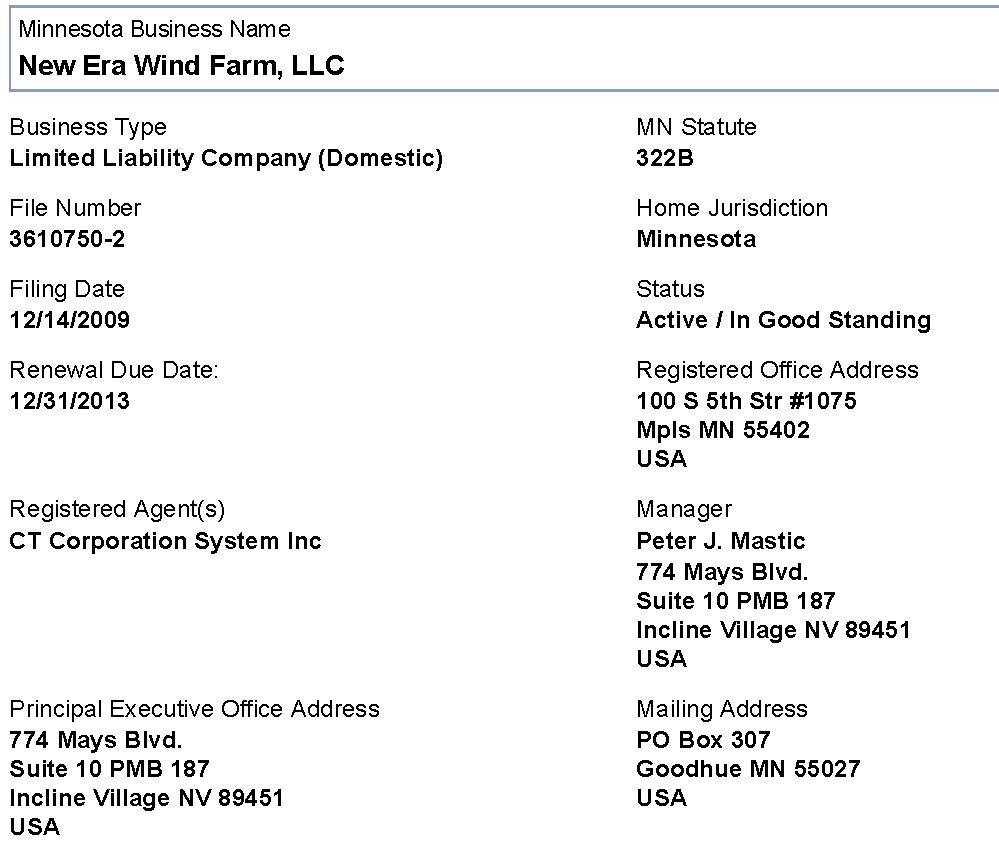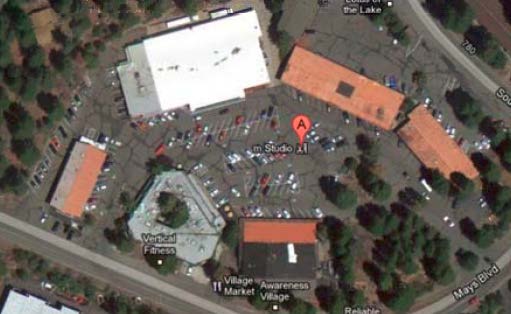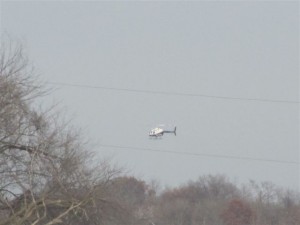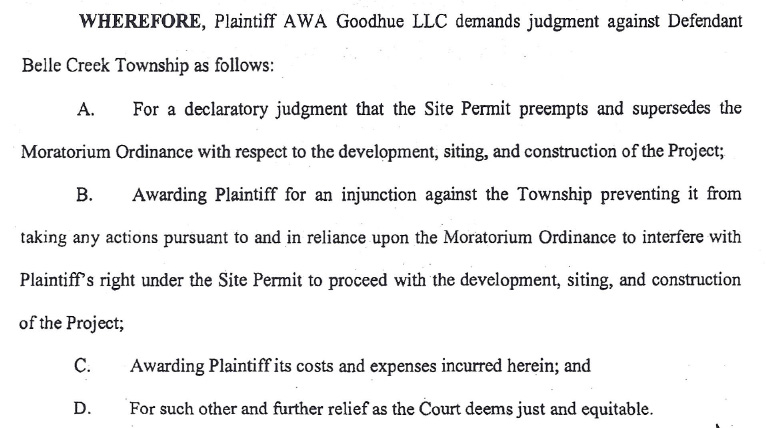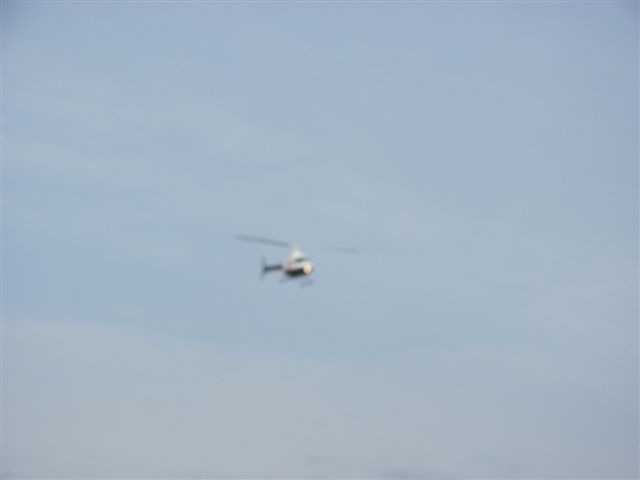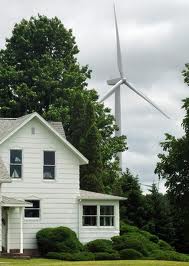Peter Mastic’s New Office!
October 14th, 2012
It’s been a busy couple of weeks in wind in Goodhue County.
It’s all about whether there is indeed anything more than vaporware to the Goodhue Wind Project. And there’s also that pesky little Community Based Energy Development statute, and whether this project is a C-BED project.
T. Boone Pickens has waved goodbye to the Goodhue Wind Project.
And in the STrib, some interesting details:
T. Boone Pickens departs state wind project
But before the Pickens announcement, we got word that December of 2011, LAST YEAR, National Wind was sold to Trishe Wind, a company in India. Then we learn that Trishe Wind doesn’t want to take on the Goodhue Wind project! Check the “Portfolio of Projects” on their site. Posted September 26, 2012, reporting a December 2011 sale:
National Wind Acquired by Trishe Wind Energy
Minneapolis, MN – September 26, 2012: National Wind LLC has been acquired by Trishe Wind Energy Inc. Trishe Wind Energy is part of Trishe Energy Group, founded in India. Trishe Energy Group is an international developer of wind energy with over 4000 MW of wind projects completed or under development in the U.S. and India. For additional information go to www.trishe.com.
Under its new ownership, National Wind—A Trishe Group Company continues to develop community-partnered wind projects in the U.S. Since the beginning of 2012, National Wind has added five members to its Minneapolis-based workforce. For additional information go to www.nationalwind.com.
The development agreement between National Wind and the American Wind Alliance (the equity owners of AWA Goodhue) with respect to the Goodhue project has been terminated as of the end of August 2012.
Which was followed up by an Information Request from Tricia DeBleekere:
SNORT! Let’s see them answer that!
And Mastic sent in another Compliance Filing that must have crossed in the mail with the PUC’s IR like two ships passing in the night:
The Secretary of State reports that a New Era Wind Farm LLC was born on December 14, 2009, and was amended October 8th and 10th, 2012.
CT Corporation System, at 100 So. 5th Str #1075, Mpls, is one of those mail-order incorporators that provide a “Registered Office Address” for service in Minnesota. Note the mailing address!
AWA Goodhue “swiftboating” Belle Creek Township!
December 16th, 2011
.
T. Boone Pickens , a/k/a AWA Goodhue Wind, a/k/a Mesa Power, is at it again, and here come the helicopters!
First, let’s take a look-see at the Complaint that AWA Goodhue served on Belle Creek Township, the little township that could, and CAN, and DOES:
Monday, the Township had a meeting where they were to discuss the road agreement that’s in negotiations right now. The Township controls township roads, and AWA’s project would require a lot of road upgrading to support the very heavy trucks and cranes, meaning that the roadbed has to be made a lot deeper, meaning that corners have to be filled in so that trucks can get around the corners, culverts could easily be damaged by the weight, and this is something within the township’s jurisdiction. And the day after the Monday meeting, AWA Goodhue serves the Town Board Chair with a Complaint! Here’s what AWA wants:
How’s that for a punch line?!?! So the Township shouldn’t have any say over the roads, the Township isn’t able to protect its interests? Right… we shall see!
And as that’s happening, I started getting calls about very low flying airplanes, startling cows and horses, and residents too! One scared a calf, which climbed over its stall and ran off — they were able to get it, and were lucky it was not injured as it climbed over. Then today, it’s helicopters, with horses running every which way, windows rattling:
AWA Goodhue’s attorney did admit they were “their” aircraft. We got the number, N144BH, which “upon information and belief” is owned by “Brainerd Helicopter Service.” AWA Goodhue’s attorney says that they’re doing avian work as specified by their (filed yesterday) Avian and Bat Protection Plan (ABPP), which states:
You tell me, does this look like 200 feet? And anyway, exactly how is this the ABPP last word on anything?
Suffice it to say, the Sheriff is on it, and they’ve called in the FAA, apparently the FAA inspector is on it too.
Wind projects aren’t benign, to birds, or to humans…
July 25th, 2011
The importance of siting properly — maybe the message is getting through? Just like a nuclear plant, you can’t be putting generators in the ground without a lot of respectful planning and consideration for neighbors, be they the people living next door or the migratory birds making their way through, or in their foraging, roosting and nesting territory.
Eagles are as much an issue here as with the CapX 2020 Brookings transmission line crossing of the Minnesota River, and will be an issue with any of the proposed crossings for the CapX 2020 transmission line across the Mississippi River, which is North America’s major migratory flight path. Eagles in the proximity of transmission lines was the reason (arguably, because the real reason was that they couldn’t use the Myrick Road route, but that’s a whole ‘nother post, see www.nocapx2020.info and search for “Myrick”).
When you’re planning utility infrastructure, and permitting it, you’ve got to have concerns for impacts, but when it’s no
longer the “Environmental Quality Board” handling it, and it’s the Dept. of COMMERCE with their COMMERCE charge, humans and eagles don’t have a chance against the corporate promoters of these projects. It’s time to transfer review back to the Environmental Quality Board and develop standards for siting (do you know there are NO standards for
siting wind projects over 25MW? They just do it on a case by case basis, with no scientific basis whatsoever), and eliminate the Dept. of Commerce and their corporate shills from any oversight of utility projects, unless they want to intervene as a party.
Yesterday there were two articles on this, in the STrib and the LA Times:
Bald eagles could thwart Red Wing wind farm
Wind farms multiply, fueling clashes with nearby residents
Here are the full articles so they’ll be around once archived. First from the STrib:
Bald eagles could thwart Red Wing wind farm
* Article by: JOSEPHINE MARCOTTY , Star Tribune
* Updated: July 25, 2011 – 1:57 AMIn battle against a Red Wing project, citizens turn to a national symbol.
But there is no certainty such a plan will succeed in protecting eagles or other endangered species.
But that’s only if the deaths are discovered.
“If there are 50 birds hit, are they going to tell anyone?” he said. “We hope they would.”
And in the L.A. Times:
Wind farms multiply, fueling clashes with nearby residents
By Tiffany Hsu, Los Angeles Times
Reporting from Tehachapi, Calif.—
Tehachapi activist Terry Warsaw said he’s worried his community will soon be surrounded by turbines.
“They are not benign things,” she said. “We’ve seen turbines go berserk.”
“Monstrous insects,” she calls them. “I look at the propellers for a moment and my head gets dizzy.”
“We are resembling hundreds of towns around the country,” she said.
Some suggest that removing trees to make way for the machines could lead to erosion and flooding.
PUC Briefing Papers for Goodhue Wind
June 23rd, 2011
Thursday, June 30, the last day before the state government shuts down, the Public Utilities Commission will hear oral arguments and deliberate and likely decide fate of the AWA/Goodhue Wind Project.
The Staff Briefing Papers matter-of-factly point out a couple of things that make a huge difference in this case:
In the ALJ’s December 8, 2010 First Prehearing Order, Order point #13 noted:
13. As noted above, the parties may submit legal argument on how the good cause standard should be applied, if at all, in their closing memoranda. In particular, the Administrative Law Judge would like the parties to brief the issue whether Minn. Stat. 216F.081 (2008) is intended to apply only to counties that have assumed the responsibility to process applications and issue permits for LWECS with a combined nameplate capacity of less than 25 MW pursuant to Minn. Stat. 216F.081. …
This is not an issue that the Commission referred to the ALJ. The ALJ’s findings on this issue are included in her report as findings #39 – 47.
And shortly after that:
Staff recommends that the Commission consider all parties‟ positions on this matter and their previous November 2, 2010 Order for Hearing (cited above).
Staff believes that if the Commission comes to the same conclusion as the November 2, 2010 Order, it should strike ALJ findings #40-46 on the basis that the Commission has already considered this matter and the matter was not referred to the ALJ. Findings #39 and 47 are general in nature and staff doesn’t believe the findings would need to be omitted.
The recommendation of staff to the Commissioners? Hold on to your seats:
Staff recommends adopting the ALJ’s Report with the following changes:
1) modifications to findings #10, 60 and 71 as outlined in Attachment B under “Staff”;
2) striking findings #40-46, as discussed above; and
3) providing for other modifications the Commission deems necessary.
YEAAAAAAA! From there to where this should be isn’t all that far…
To watch the oral arguments and PUC’s deliberation, CLICK HERE and then click the blue button to “Watch Webcast!” Or come on down, Thursday, 9:30 a.m. ( a little after, we’re 2 and 3 on the agenda), at 121 – 7th Place East, 3rd Floor, Large Hearing Room, St. Paul, MN, 55101.
Goodhue Wind Docket … REFILE!
March 2nd, 2011
Order to refile exhibits, and Goodhue Wind Truths’ Subpoena requests denied!
Whew — actually it helps. We got an order yesterday that we need to refile the Testimony. There’s so much and it doesn’t fit into neat little bundles that can be filed with the eFile system, and I’m glad I wasn’t the only one having trouble with that.
But the denial of the subpoena requests sucks. MOES had filed Affidavits related to intent, and we’ve not had the opportunity to cross regarding their assertions:
MOES Comments – Affidavit of Ingrid Bjorklund
AWA Goodhue’s Motion for Summary Disposition (see p. 10)
Ingrid Bjorklund was a wind industry lobbyist at the time this was winding through the legislature, yet here she is, as a Commerce employee, making a statement in an Affidavit, under oath, conclusory statements about legislative intent. EH? Both documents above contain statements about what Mikey Bull may or may not have said. What’s Michael Bull got to do with legislative intent? To borrow a fist-pounding-the-desk phrase from Rep. Dennis Ozment, “I don’t recall electing NSP to the legislature!” Oh wait, he was there at the Green Chameleon Gov’s behest then…
So I decided to requests subpoenas for both Ingrid Bjorklund and Mike Bull:
Goodhue Wind Truth – Subpoena Requests for Bjorklund and Bull
Are we having fun yet? Xcel’s Chris Clark seemed to think so when I gave him the heads up at Thursday’s PUC meeting!
Not to worry, folks, the ALJ denied the request…
ALJ Sheehy’s Letter to Overland – Denial of Subpoena Requests
And now, for something completely different… back to reformatting all the exhibits… oh, what I would do for support staff, the grrrrrrrrrls just can’t work a computer without drooling on the keyboard!


